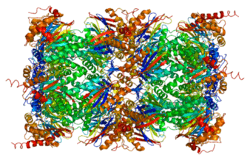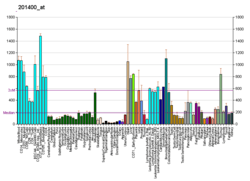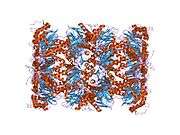PSMB3
Proteasome subunit beta type-3, also known as 20S proteasome subunit beta-3, is a protein that in humans is encoded by the PSMB3 gene.[5] This protein is one of the 17 essential subunits[6] that contribute to the complete assembly of the 20S proteasome complex. In particular, proteasome subunit beta type-2, along with other beta subunits, assemble into two heptameric rings and subsequently a proteolytic chamber for substrate degradation. The eukaryotic proteasome recognizes degradable proteins, including damaged proteins for protein quality control purpose or key regulatory protein components for dynamic biological processes.
Structure
Protein expression
The gene PSMB3 encodes a member of the proteasome B-type family, also known as the T1B family, that is a 20S core beta subunit. Pseudogenes have been identified on chromosomes 2 and 12.[7] The gene has 6 exons and locates at chromosome band 17q12. The human protein proteasome subunit beta type-3 is 23 kDa in size and composed of 205 amino acids. The calculated theoretical pI of this protein is 6.14.
Complex assembly
The proteasome is a multicatalytic proteinase complex with a highly ordered 20S core structure. This barrel-shaped core structure is composed of 4 axially stacked rings of 28 non-identical subunits: the two end rings are each formed by 7 alpha subunits, and the two central rings are each formed by 7 beta subunits. Three beta subunits (beta1, beta2, and beta5) each contain a proteolytic active site and have distinct substrate preferences. Proteasomes are distributed throughout eukaryotic cells at a high concentration and cleave peptides in an ATP/ubiquitin-dependent process in a non-lysosomal pathway.[8][9]
Function
Protein functions are supported by its tertiary structure and its interaction with associating partners. As one of 28 subunits of 20S proteasome, protein proteasome subunit beta type-3 contributes to form a proteolytic environment for substrate degradation. Evidences of the crystal structures of isolated 20S proteasome complex demonstrate that the two rings of beta subunits form a proteolytic chamber and maintain all their active sites of proteolysis within the chamber.[9] Concomitantly, the rings of alpha subunits form the entrance for substrates entering the proteolytic chamber. In an inactivated 20S proteasome complex, the gate into the internal proteolytic chamber are guarded by the N-terminal tails of specific alpha-subunit. This unique structure design prevents random encounter between proteolytic active sites and protein substrate, which makes protein degradation a well-regulated process.[10][11] 20S proteasome complex, by itself, is usually functionally inactive. The proteolytic capacity of 20S core particle (CP) can be activated when CP associates with one or two regulatory particles (RP) on one or both side of alpha rings. These regulatory particles include 19S proteasome complexes, 11S proteasome complex, etc. Following the CP-RP association, the confirmation of certain alpha subunits will change and consequently cause the opening of substrate entrance gate. Besides RPs, the 20S proteasomes can also be effectively activated by other mild chemical treatments, such as exposure to low levels of sodium dodecylsulfate (SDS) or NP-14.[11][12]
Clinical significance
The proteasome and its subunits are of clinical significance for at least two reasons: (1) a compromised complex assembly or a dysfunctional proteasome can be associated with the underlying pathophysiology of specific diseases, and (2) they can be exploited as drug targets for therapeutic interventions. Recently, more effort has been made to consider the proteasome for the development of novel diagnostic markers and strategies. An improved and comprehensive understanding of the pathophysiology of the proteasome should lead to clinical applications in the future.
The proteasomes form a pivotal component for the ubiquitin–proteasome system (UPS) [13] and corresponding cellular Protein Quality Control (PQC). Protein ubiquitination and subsequent proteolysis and degradation by the proteasome are important mechanisms in the regulation of the cell cycle, cell growth and differentiation, gene transcription, signal transduction and apoptosis.[14] Subsequently, a compromised proteasome complex assembly and function lead to reduced proteolytic activities and the accumulation of damaged or misfolded protein species. Such protein accumulation may contribute to the pathogenesis and phenotypic characteristics in neurodegenerative diseases,[15][16] cardiovascular diseases,[17][18][19] inflammatory responses and autoimmune diseases,[20] and systemic DNA damage responses leading to malignancies.[21]
Several experimental and clinical studies have indicated that aberrations and deregulations of the UPS contribute to the pathogenesis of several neurodegenerative and myodegenerative disorders, including Alzheimer's disease,[22] Parkinson's disease[23] and Pick's disease,[24] Amyotrophic lateral sclerosis (ALS),[24] Huntington's disease, Creutzfeldt–Jakob disease, and motor neuron diseases, polyglutamine (PolyQ) diseases, Muscular dystrophies[25] and several rare forms of neurodegenerative diseases associated with dementia.[26] As part of the ubiquitin–proteasome system (UPS), the proteasome maintains cardiac protein homeostasis and thus plays a significant role in cardiac ischemic injury,[27] ventricular hypertrophy[28] and heart failure.[29] Additionally, evidence is accumulating that the UPS plays an essential role in malignant transformation. UPS proteolysis plays a major role in responses of cancer cells to stimulatory signals that are critical for the development of cancer. Accordingly, gene expression by degradation of transcription factors, such as p53, c-jun, c-Fos, NF-κB, c-Myc, HIF-1α, MATα2, STAT3, sterol-regulated element-binding proteins and androgen receptors are all controlled by the UPS and thus involved in the development of various malignancies.[30] Moreover, the UPS regulates the degradation of tumor suppressor gene products such as adenomatous polyposis coli (APC) in colorectal cancer, retinoblastoma (Rb). and von Hippel–Lindau tumor suppressor (VHL), as well as a number of proto-oncogenes (Raf, Myc, Myb, Rel, Src, Mos, ABL). The UPS is also involved in the regulation of inflammatory responses. This activity is usually attributed to the role of proteasomes in the activation of NF-κB which further regulates the expression of pro inflammatory cytokines such as TNF-α, IL-β, IL-8, adhesion molecules (ICAM-1, VCAM-1, P-selectin) and prostaglandins and nitric oxide (NO).[20] Additionally, the UPS also plays a role in inflammatory responses as regulators of leukocyte proliferation, mainly through proteolysis of cyclines and the degradation of CDK inhibitors.[31] Lastly, autoimmune disease patients with SLE, Sjögren syndrome and rheumatoid arthritis (RA) predominantly exhibit circulating proteasomes which can be applied as clinical biomarkers.[32]
Interactions
PSMB3 has been shown to interact with PLK1.[33]
References
- ENSG00000275903 GRCh38: Ensembl release 89: ENSG00000277791, ENSG00000275903 - Ensembl, May 2017
- GRCm38: Ensembl release 89: ENSMUSG00000069744 - Ensembl, May 2017
- "Human PubMed Reference:". National Center for Biotechnology Information, U.S. National Library of Medicine.
- "Mouse PubMed Reference:". National Center for Biotechnology Information, U.S. National Library of Medicine.
- Nothwang HG, Tamura T, Tanaka K, Ichihara A (Oct 1994). "Sequence analyses and inter-species comparisons of three novel human proteasomal subunits, HsN3, HsC7-I and HsC10-II, confine potential proteolytic active-site residues". Biochimica et Biophysica Acta (BBA) - Gene Structure and Expression. 1219 (2): 361–8. doi:10.1016/0167-4781(94)90060-4. PMID 7918633.
- Alongside alpha subunits 1-7, constitutive beta subunits 1-7, and inducible subunits including beta1i, beta2i, beta5i
- "Entrez Gene: PSMB3 proteasome (prosome, macropain) subunit, beta type, 3".
- Coux O, Tanaka K, Goldberg AL (1996). "Structure and functions of the 20S and 26S proteasomes". Annual Review of Biochemistry. 65: 801–47. doi:10.1146/annurev.bi.65.070196.004101. PMID 8811196.
- Tomko RJ, Hochstrasser M (2013). "Molecular architecture and assembly of the eukaryotic proteasome". Annual Review of Biochemistry. 82: 415–45. doi:10.1146/annurev-biochem-060410-150257. PMC 3827779. PMID 23495936.
- Groll M, Ditzel L, Löwe J, Stock D, Bochtler M, Bartunik HD, Huber R (Apr 1997). "Structure of 20S proteasome from yeast at 2.4 A resolution". Nature. 386 (6624): 463–71. Bibcode:1997Natur.386..463G. doi:10.1038/386463a0. PMID 9087403.
- Groll M, Bajorek M, Köhler A, Moroder L, Rubin DM, Huber R, Glickman MH, Finley D (Nov 2000). "A gated channel into the proteasome core particle". Nature Structural Biology. 7 (11): 1062–7. doi:10.1038/80992. PMID 11062564.
- Zong C, Gomes AV, Drews O, Li X, Young GW, Berhane B, Qiao X, French SW, Bardag-Gorce F, Ping P (Aug 2006). "Regulation of murine cardiac 20S proteasomes: role of associating partners". Circulation Research. 99 (4): 372–80. doi:10.1161/01.RES.0000237389.40000.02. PMID 16857963.
- Kleiger G, Mayor T (Jun 2014). "Perilous journey: a tour of the ubiquitin–proteasome system". Trends in Cell Biology. 24 (6): 352–9. doi:10.1016/j.tcb.2013.12.003. PMC 4037451. PMID 24457024.
- Goldberg AL, Stein R, Adams J (Aug 1995). "New insights into proteasome function: from archaebacteria to drug development". Chemistry & Biology. 2 (8): 503–8. doi:10.1016/1074-5521(95)90182-5. PMID 9383453.
- Sulistio YA, Heese K (Jan 2015). "The Ubiquitin–Proteasome System and Molecular Chaperone Deregulation in Alzheimer's Disease". Molecular Neurobiology. 53 (2): 905–31. doi:10.1007/s12035-014-9063-4. PMID 25561438.
- Ortega Z, Lucas JJ (2014). "Ubiquitin–proteasome system involvement in Huntington's disease". Frontiers in Molecular Neuroscience. 7: 77. doi:10.3389/fnmol.2014.00077. PMC 4179678. PMID 25324717.
- Sandri M, Robbins J (Jun 2014). "Proteotoxicity: an underappreciated pathology in cardiac disease". Journal of Molecular and Cellular Cardiology. 71: 3–10. doi:10.1016/j.yjmcc.2013.12.015. PMC 4011959. PMID 24380730.
- Drews O, Taegtmeyer H (Dec 2014). "Targeting the ubiquitin-proteasome system in heart disease: the basis for new therapeutic strategies". Antioxidants & Redox Signaling. 21 (17): 2322–43. doi:10.1089/ars.2013.5823. PMC 4241867. PMID 25133688.
- Wang ZV, Hill JA (Feb 2015). "Protein quality control and metabolism: bidirectional control in the heart". Cell Metabolism. 21 (2): 215–26. doi:10.1016/j.cmet.2015.01.016. PMC 4317573. PMID 25651176.
- Karin M, Delhase M (Feb 2000). "The I kappa B kinase (IKK) and NF-kappa B: key elements of proinflammatory signalling". Seminars in Immunology. 12 (1): 85–98. doi:10.1006/smim.2000.0210. PMID 10723801.
- Ermolaeva MA, Dakhovnik A, Schumacher B (Sep 2015). "Quality control mechanisms in cellular and systemic DNA damage responses". Ageing Research Reviews. 23 (Pt A): 3–11. doi:10.1016/j.arr.2014.12.009. PMC 4886828. PMID 25560147.
- Checler F, da Costa CA, Ancolio K, Chevallier N, Lopez-Perez E, Marambaud P (Jul 2000). "Role of the proteasome in Alzheimer's disease". Biochimica et Biophysica Acta (BBA) - Molecular Basis of Disease. 1502 (1): 133–8. doi:10.1016/s0925-4439(00)00039-9. PMID 10899438.
- Chung KK, Dawson VL, Dawson TM (Nov 2001). "The role of the ubiquitin-proteasomal pathway in Parkinson's disease and other neurodegenerative disorders". Trends in Neurosciences. 24 (11 Suppl): S7–14. doi:10.1016/s0166-2236(00)01998-6. PMID 11881748.
- Ikeda K, Akiyama H, Arai T, Ueno H, Tsuchiya K, Kosaka K (Jul 2002). "Morphometrical reappraisal of motor neuron system of Pick's disease and amyotrophic lateral sclerosis with dementia". Acta Neuropathologica. 104 (1): 21–8. doi:10.1007/s00401-001-0513-5. PMID 12070660.
- Mathews KD, Moore SA (Jan 2003). "Limb-girdle muscular dystrophy". Current Neurology and Neuroscience Reports. 3 (1): 78–85. doi:10.1007/s11910-003-0042-9. PMID 12507416.
- Mayer RJ (Mar 2003). "From neurodegeneration to neurohomeostasis: the role of ubiquitin". Drug News & Perspectives. 16 (2): 103–8. doi:10.1358/dnp.2003.16.2.829327. PMID 12792671.
- Calise J, Powell SR (Feb 2013). "The ubiquitin proteasome system and myocardial ischemia". American Journal of Physiology. Heart and Circulatory Physiology. 304 (3): H337–49. doi:10.1152/ajpheart.00604.2012. PMC 3774499. PMID 23220331.
- Predmore JM, Wang P, Davis F, Bartolone S, Westfall MV, Dyke DB, Pagani F, Powell SR, Day SM (Mar 2010). "Ubiquitin proteasome dysfunction in human hypertrophic and dilated cardiomyopathies". Circulation. 121 (8): 997–1004. doi:10.1161/circulationaha.109.904557. PMC 2857348. PMID 20159828.
- Powell SR (Jul 2006). "The ubiquitin–proteasome system in cardiac physiology and pathology". American Journal of Physiology. Heart and Circulatory Physiology. 291 (1): H1–H19. doi:10.1152/ajpheart.00062.2006. PMID 16501026.
- Adams J (Apr 2003). "Potential for proteasome inhibition in the treatment of cancer". Drug Discovery Today. 8 (7): 307–15. doi:10.1016/s1359-6446(03)02647-3. PMID 12654543.
- Ben-Neriah Y (Jan 2002). "Regulatory functions of ubiquitination in the immune system". Nature Immunology. 3 (1): 20–6. doi:10.1038/ni0102-20. PMID 11753406.
- Egerer K, Kuckelkorn U, Rudolph PE, Rückert JC, Dörner T, Burmester GR, Kloetzel PM, Feist E (Oct 2002). "Circulating proteasomes are markers of cell damage and immunologic activity in autoimmune diseases". The Journal of Rheumatology. 29 (10): 2045–52. PMID 12375310.
- Feng Y, Longo DL, Ferris DK (Jan 2001). "Polo-like kinase interacts with proteasomes and regulates their activity". Cell Growth & Differentiation. 12 (1): 29–37. PMID 11205743.
Further reading
- Coux O, Tanaka K, Goldberg AL (1996). "Structure and functions of the 20S and 26S proteasomes". Annual Review of Biochemistry. 65: 801–47. doi:10.1146/annurev.bi.65.070196.004101. PMID 8811196.
- Goff SP (Aug 2003). "Death by deamination: a novel host restriction system for HIV-1". Cell. 114 (3): 281–3. doi:10.1016/S0092-8674(03)00602-0. PMID 12914693.
- Rasmussen HH, van Damme J, Puype M, Gesser B, Celis JE, Vandekerckhove J (Dec 1992). "Microsequences of 145 proteins recorded in the two-dimensional gel protein database of normal human epidermal keratinocytes". Electrophoresis. 13 (12): 960–9. doi:10.1002/elps.11501301199. PMID 1286667.
- Kristensen P, Johnsen AH, Uerkvitz W, Tanaka K, Hendil KB (Dec 1994). "Human proteasome subunits from 2-dimensional gels identified by partial sequencing". Biochemical and Biophysical Research Communications. 205 (3): 1785–9. doi:10.1006/bbrc.1994.2876. PMID 7811265.
- Seeger M, Ferrell K, Frank R, Dubiel W (Mar 1997). "HIV-1 tat inhibits the 20 S proteasome and its 11 S regulator-mediated activation". The Journal of Biological Chemistry. 272 (13): 8145–8. doi:10.1074/jbc.272.13.8145. PMID 9079628.
- McCusker D, Jones T, Sheer D, Trowsdale J (Oct 1997). "Genetic relationships of the genes encoding the human proteasome beta subunits and the proteasome PA28 complex". Genomics. 45 (2): 362–7. doi:10.1006/geno.1997.4948. PMID 9344661.
- Madani N, Kabat D (Dec 1998). "An endogenous inhibitor of human immunodeficiency virus in human lymphocytes is overcome by the viral Vif protein". Journal of Virology. 72 (12): 10251–5. doi:10.1128/JVI.72.12.10251-10255.1998. PMC 110608. PMID 9811770.
- Simon JH, Gaddis NC, Fouchier RA, Malim MH (Dec 1998). "Evidence for a newly discovered cellular anti-HIV-1 phenotype". Nature Medicine. 4 (12): 1397–400. doi:10.1038/3987. PMID 9846577.
- Elenich LA, Nandi D, Kent AE, McCluskey TS, Cruz M, Iyer MN, Woodward EC, Conn CW, Ochoa AL, Ginsburg DB, Monaco JJ (Sep 1999). "The complete primary structure of mouse 20S proteasomes". Immunogenetics. 49 (10): 835–42. doi:10.1007/s002510050562. PMID 10436176.
- Mulder LC, Muesing MA (Sep 2000). "Degradation of HIV-1 integrase by the N-end rule pathway". The Journal of Biological Chemistry. 275 (38): 29749–53. doi:10.1074/jbc.M004670200. PMID 10893419.
- Feng Y, Longo DL, Ferris DK (Jan 2001). "Polo-like kinase interacts with proteasomes and regulates their activity". Cell Growth & Differentiation. 12 (1): 29–37. PMID 11205743.
- Sheehy AM, Gaddis NC, Choi JD, Malim MH (Aug 2002). "Isolation of a human gene that inhibits HIV-1 infection and is suppressed by the viral Vif protein". Nature. 418 (6898): 646–50. Bibcode:2002Natur.418..646S. doi:10.1038/nature00939. PMID 12167863.
- Huang X, Seifert U, Salzmann U, Henklein P, Preissner R, Henke W, Sijts AJ, Kloetzel PM, Dubiel W (Nov 2002). "The RTP site shared by the HIV-1 Tat protein and the 11S regulator subunit alpha is crucial for their effects on proteasome function including antigen processing". Journal of Molecular Biology. 323 (4): 771–82. doi:10.1016/S0022-2836(02)00998-1. PMID 12419264.
- Gaddis NC, Chertova E, Sheehy AM, Henderson LE, Malim MH (May 2003). "Comprehensive investigation of the molecular defect in vif-deficient human immunodeficiency virus type 1 virions". Journal of Virology. 77 (10): 5810–20. doi:10.1128/JVI.77.10.5810-5820.2003. PMC 154025. PMID 12719574.
- Lecossier D, Bouchonnet F, Clavel F, Hance AJ (May 2003). "Hypermutation of HIV-1 DNA in the absence of the Vif protein". Science. 300 (5622): 1112. doi:10.1126/science.1083338. PMID 12750511.
- Zhang H, Yang B, Pomerantz RJ, Zhang C, Arunachalam SC, Gao L (Jul 2003). "The cytidine deaminase CEM15 induces hypermutation in newly synthesized HIV-1 DNA". Nature. 424 (6944): 94–8. Bibcode:2003Natur.424...94Z. doi:10.1038/nature01707. PMC 1350966. PMID 12808465.
- Mangeat B, Turelli P, Caron G, Friedli M, Perrin L, Trono D (Jul 2003). "Broad antiretroviral defence by human APOBEC3G through lethal editing of nascent reverse transcripts". Nature. 424 (6944): 99–103. Bibcode:2003Natur.424...99M. doi:10.1038/nature01709. PMID 12808466.






